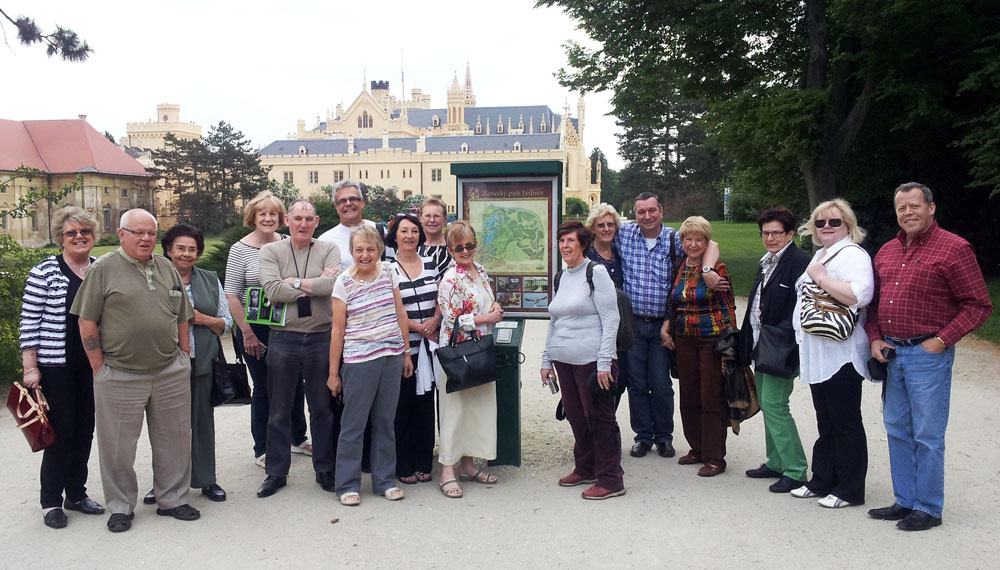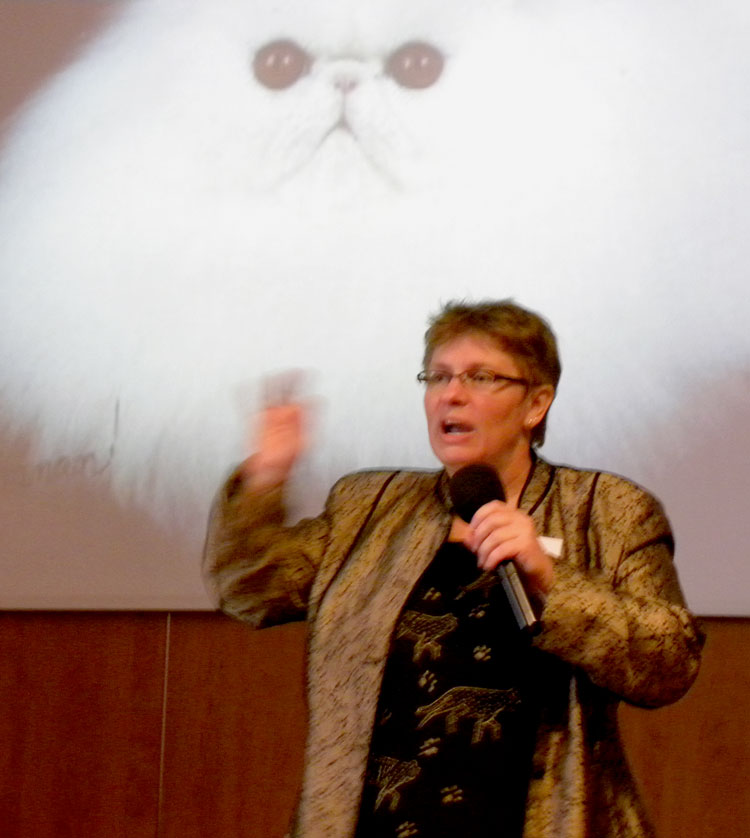
The delegates to the World Cat Congress. From left to right, front row: Anneliese Hackmann (WCF), Cheryle U'Ren (CCCA), Lesley Morgan Blythe (ACF), Penny Bydlinski (Secretry) and Helen Marriott-Power (GCCF) and back row: Vickie Fisher (TICA), Wayne Trevathan (CFA), Eric Reijers (President), Annette Sjödin (FIFe), Jan van Rooyen (SACC).
This year’s meeting was blessed with beautiful weather which the delegates were able to enjoy during the outing which took place on the Thursday. A coach drove the delegates and other visitors to Lednice castle, which is set in a very lovely park. The delegates walked through the park and the village before embarking on a boat to take a trip through the waterways of the Estate. This is a protected area of natural beauty where, amongst other wildlife, beavers inhabit the quiet area of the water and evidence of their activities can easily be sees in the marks on the trees as well as the trees lying in the water. This was followed by lunch at a local hostelry which was very kindly sponsored by FIFe.

At the Lednice Castle. From left to right: Wayne Trevathan (CFA), Jan van Rooyen (SACC), Karl Preiss (FIFe), Steve Crow (GCCF), Eric Reijers (WCC President). Andreas Möbius (WCF) Vickie Fisher (TiCA). Front Row: Chris Lowe (NZCF), Cheryle U'Ren (CCCA), Penny Bydlinski (WCC Secretary), Julian Schuller (ACF).
There was an interesting programme which started with a lecture by Professor Tim Gruffyd-Jones from the University of Bristol in England. Prof Gruffyd-Jones is a well-known and very able speaker who, on this occasion, based his lecture on the health regulations in place in both FIFe and the GCCF. He underlined the fact that the cat fancy was under scrutiny and needed to become proactive rather than reactive. He felt that some of the rules in place in FIFe, such as the rule that breeding cats had to be micro-chipped or DNA registered, were good.

Professor Tim Gruffyd-Jones speaking at WCC 2012 Seminar.
He emphasized that some genetic testing needed to be implemented by clinical tests and cited cardiomyopathy by ultrasound as an example. He thought that X-rays were appropriate for his dysplasia but not for luxating patella where clinical manipulation was preferable.
He thought it was not a sound strategy to nominate specific diseases to specific breeds (such as PKD) as these could also be found in non-pedigree cat populations. Recessive disorders were found to be the most common. The protocol of compulsorily testing Korats for gangliosidosis had virtually eliminated it. He further pointed out that recessive disorders could be eliminated two to three generations if there was a genetic test available. He also mentioned PRD in aby/somali, Aussie Mist etc, as well as Piruvate Kinase deficiency where the red cells rupture causing anaemia
PKD - renal failure was caused by a dominant gene. It was seen in Persian/Exotic and related breeds. He explained that if the gene was present the cat had the syndrome. To mate two cats who had the gene would be lethal. He said that in order to retain the gene pool it would be advisable to mate one cat that was clear with one who had the gene. The results would be 50% affected and 50% unaffected. The affected cats could be detected by ultrasound although the cysts could take time to develop. He felt a balance had to be found to manage these problems without wiping out the breed.
Turning to blood groups and the affect of incompatible groups, which could lead to fatal anaemia in kittens, he warned about too drastic solutions, which could lead to the loss of a wide genetic pool. It was also not yet known what else would be affected if one particular blood group were to be eliminated.
In his opinion the registering bodies should be deciding on the tests required and should also have the authority to introduce such tests. Through registrations they would be able to ensure the tests were carried out.
Speaking about cardiomyopathy in Ragdolls and Maine Coons, he explained it showed different mutations. He said he had seen the following rations for HCM: unaffected 70%, heterozygous 30% and homozygous 2%. Although it was a dominant gene, not all died in utero, the gene test could not predict absolutely and also the disease could occur for other reasons that were not genetic. The aim would be not to breed homozygous cats. Ultrasound scanning may be used as a diagnostic tool.
Speaking generally, he talked about the continuing breakthroughs in technology, the catastrophic diseased and the extremes of conformation in some of the cat breeds. He warned that no matter which breed, the perception of the fancy in the public eye ultimately affected the whole of the fancy and all the breeders.
He advocated good husbandry, saying that six cats were the maximum for good management, more than that resulted in behavioural problems, respiratory viruses and FIP.
This lecture was greeted with general applause; it had been a helpful and very clear explanation of certain conditions, which was much appreciated.

Leslie Lyons speaking at the WCC 2012 Seminarr.
Leslie Lyons, the next lecturer is ever popular with both breeders and judges. She has a happy knack of involving her audience and presenting her material in a way that is easy to understand.
Her subject was genetic tests and she started by outlining her work on categorizing the origins of various breeds. She mentioned the 33 genes in cats and the 51 mutations; there were also 37 phenotypes. She also discussed infertility, such as the F1 generation in the Bengals and the chimera tortoiseshell male.
She went on to discuss various genetic diseases. With regard to PKD, she said that a secondary gene was at work and also recommended ultrasound as a clinical test as it was not known how fast the progress of the disease would be in an individual cat. She was planning to publish a paper on PKD.
Regarding the A and B blood group, she said that this had not yet been fully studied. It may play some part in resistance to disease and she added that a paper had been published on this subject.
On Feline Retinal Degeneration she spoke of the two types in Abys quoting various published authorities. She outlined her hypothesis that Siamese cats could be blind without their owners realizing it and the possibility that another gene was over-riding the effect in certain affected cats.
She quoted Glycogen Storage Disease IV as diagnosed in the Norwegian Forest Cat as being autosomal recessive.
Regarding Hypokalaemia, she referred to a paper published in 1986 by Professor Gryffyd-Jones. It was known in Burmese and was a potassium disorder.
Speaking of the Burmese head defect which had appeared in the 1970s and pointed out that it was not commensurate with life and that euthanasia was the only option. She hoped that the WCC would take an active role in eradicating this gene as even heterozygous individuals had problems and it was a condition that needed to be eradicated. She encouraged the development of an outcrossing programme; possible outcrosses could be Korats, Kao Manee etc. She thought the fancy needed to think ‘outside of the box’ and added that any S.E. Asian cats could help. Other breeds that may be affected were the Bombay, the Singapura, the Tonkinese, the American Shorthair and even maybe the Ragdoll.
Speaking of the longhair mutation, she said there were four mutations, the highest number being in Iran. She had also determined that the Van and the Angora were two different breeds. There was a general discussion on the extent and the individuality of cats on the Greek Islands and on Cyprus, the Aphrodite.
She advocated that breeders should test where possible for the known conditions and strongly advised getting rid of breeding contracts. She thought Burmese should be considered as all one breed and she then suggested a year be allocated to type everything.
This was another very well received lecture and everybody will look forward to further developments in the genetic field.

Mrs Sarah Rivière, the Manager of Royal Canin’s Marketing International
The next speaker was Mrs Sarah Rivière, the Manager of Royal Canin’s Marketing International who was once again able to join the WCC. Royal Canin is the sponsor of WCC and as such plays an important part.
She quoted Hippocrates the Greek physician of the 4th Century BC and the ‘father of medicine’ who had said, “Let your food be your first medicine” She spoke of Royal Canin’s mission to use the knowledge of experts on dogs and cats and to bring it forward. They had started the health and nutrition policies in 1967 and it had evolved. She referred to the different needs of different breeds and said that Royal Canin worked closely with breeders and with veterinarians. Their knowledge was collected from scientific sources and also from observation. They evaluated a product before it went into production. Mentioning eating habits of different breeds, she said that the first breed product they had produced had been for the Persian with its particular needs. Her final message was that Royal Canin had a passion to share. Her talk was not long but covered essential points and was enthusiastically received.
The next item on the Agenda was a group exercise that involved everybody. The attendees were divided into groups and Mr Reijers had arranged for a number of British in various colours and patterns to be brought along for the participants to assess as to their colour, pattern and texture. This was an interesting exercise which gave rise to a lot of discussion and, above all, it was very nice to have cats present on this occasion.
The final point on the agenda was a brief presentation by the individual delegates of the education of student judges and judges in their own bodies. This was interesting and as ever the participants learned that there is always a good idea to be gleaned from another organisation.
The meeting ended with an open session in which the participants could ask the delegates questions. Much of it was taken up by the concerns of one visiting organisation but there were some interesting points made which will be covered in the official Minutes of the business meeting.
The next two days were taken up with the show, which was run by the ZO Moravia Cat Club. It was held in the same hotel, which made it very easy for the delegates. It was a busy show where several of the delegates officiated as judges. It is always an interesting experience for judges from other organisations to see the cats at these shows; equally it is interesting for the exhibitors to hear the opinions of the visiting judges.
After a tiring but interesting weekend, the delegates had a relaxing evening before the main business meeting of the WCC which took place the following day.
The Minutes of the meeting are available for download.





